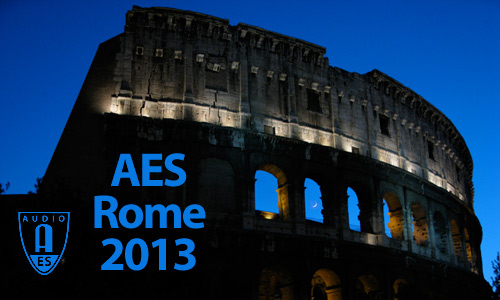
AES Rome 2013
Paper Session P3
P3 - Perception
Saturday, May 4, 14:15 — 17:15 (Sala Carducci)
Chair:
Frank Melchior, BBC Research and Development - Salford, UK
P3-1 The Relation between Preferred TV Program Loudness, Screen Size, and Display Format—Ian Dash, Consultant - Marrickville, NSW, Australia; Todd Power, University of Sydney - Sydney, NSW, Australia; Densil A. Cabrera, University of Sydney - Sydney, NSW, Australia
The effect of television screen size and display format on preferred TV program loudness was investigated by listening tests using typical program material. While no significant influence on preferred program loudness was observed from screen size or color level, other preference patterns related to soundtrack content type were observed that are of interest.
Convention Paper 8817 (Purchase now)
P3-2 Vibration in Music Perception—Sebastian Merchel, Dresden University of Technology - Dresden, Germany; M. Ercan Altinsoy, Dresden University of Technology - Dresden, Germany
The coupled perception of sound and vibration is a well-known phenomenon during live pop or organ concerts. However, even during a symphonic concert in a classical hall, sound can excite perceivable vibrations on the surface of the body. This study analyzes the influence of audio-induced vibrations on the perceived quality of the concert experience. Therefore, sound and seat vibrations are controlled separately in an audio reproduction scenario. Because the correlation between sound and vibration is naturally strong, vibrations are generated from audio recordings using various approaches. Different parameters during this process (frequency and intensity modifications) are examined in relation to their perceptual consequences using psychophysical experiments. It can be concluded that vibrations play a significant role during the perception of music.
Convention Paper 8818 (Purchase now)
P3-3 An Assessment of Virtual Surround Sound Systems for Headphone Listening of 5.1 Multichannel Audio—Chris Pike, BBC Research and Development - Salford, York, UK; Frank Melchior, BBC Research and Development - Salford, UK
It is now common for broadcast signals to feature 5.1 surround sound. It is also increasingly common that audiences access broadcast content on portable devices using headphones. Binaural techniques can be applied to create a spatially enhanced headphone experience from surround sound content. This paper presents a subjective assessment of the sound quality of 12 state-of-the-art systems for converting 5.1 surround sound to a 2-channel signal for headphone listening. A multiple stimulus test was used with hidden reference and anchors; the reference stimulus was an ITU stereo down-mix. Dynamic binaural synthesis, based on individualized binaural room impulse response measurements and head orientation tracking, was also incorporated into the test. The experimental design and detailed analysis of the results are presented in this paper.
Convention Paper 8819 (Purchase now)
P3-4 Effect of Target Signal Envelope on Direction Discrimination in Spatially Complex Sound Scenarios—Olli Santala, Aalto University School of Electrical Engineering - Aalto, Finland; Marko Takanen, Aalto University School of Electrical Engineering - Aalto, Finland; Ville Pulkki, Aalto University - Aalto, Finland
The temporal envelope of a sound signal has been found to have an effect on localization. Whether this is valid for spatially complex scenarios was addressed by conducting a listening experiment in which a spatially distributed sound source consisted of a target between two interfering noise-like sound sources, all emitting sound simultaneously. All the signals were harmonic complex tones with components within 2 kHz–8.2 kHz and were presented using loudspeaker reproduction in an anechoic chamber. The phases of the harmonic tones of the target signal were altered, causing the envelope to change. The results indicated that prominent peaks in the envelope of the target signal aided in the discrimination of its direction inside the widely distributed sound source.
Convention Paper 8820 (Purchase now)
P3-5 A Framework for Adaptive Real-Time Loudness Control—Andrea Alemanno, Sapienza University of Rome - Rome, Italy; Alessandro Travaglini, Fox International Channels Italy - Guidonia Montecelio (RM), Italy; Simone Scardapane, Sapienza University of Rome - Rome, Italy; Danilo Comminiello, Sapienza University of Rome - Rome, Italy; Aurelio Uncini, Sapienza University of Rome - Rome, Italy
Over the last few years, loudness control represents one of the most frequently investigated topics in audio signal processing. In this paper we describe a framework designed to provide adaptive real-time loudness measurement and processing of audio files and streamed content being reproduced by mobile players hosted in laptops, tablets, and mobile phones. The proposed method aims to improve the users’ listening experience by normalizing the loudness level of the content in real-time, while preserving the original creative intent of the original soundtrack. The loudness measurement and adaptation is based on a customization of the High Efficiency Loudness Model algorithm described in the AES Convention Paper #8612 (“HELM: High Efficiency Loudness Model for Broadcast Content,” presented at the 132nd Convention, April 2012). Technical and subjective tests were performed in order to evaluate the performance of the proposed method. In addition, the way the subjective test was arranged offered the opportunity to gather information on the preferred Target Level of streamed and media files reproduced on portable devices.
Convention Paper 8821 (Purchase now)
P3-6 The Perception of Masked Sounds and Reverberation in 3-D vs. 2-D Playback Systems—Giulio Cengarle, Imm Sound S.A., a Dolby company - Barcelona, Spain; Alexandre Pereda, Fundació Barcelona Media - Barcelona, Spain
This paper presents studies on perceptual aspects of spatial audio and their dependency on the playback format. The first study regards the perception of sound in the presence of a masker in stereo, 5.1, and 3-D. Psychoacoustic tests show that the detection threshold improves with the spread of the masker, which justifies the claim that individual elements of dense soundtracks are more audible when they are distributed in a wider panorama. The second study indicates that the perception of the reverberation level does not depend on the playback format. The joint interpretation of these results justifies the claim that in 3-D sound engineers can use higher levels of reverberation without compromising the intelligibility of the sound sources.
Convention Paper 8822 (Purchase now)
